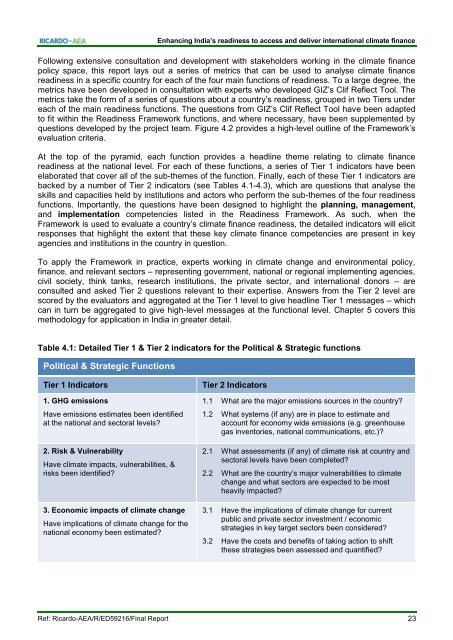Enhancing India’s Readiness to Climate Finance
India has taken several steps to improve its national response to climate change. India’s climate finance requirements, however, are very high, and will need to be met through a combination of public, private and international climate finance. See more at: http://shaktifoundation.in/
India has taken several steps to improve its national response to climate change. India’s climate finance requirements, however, are very high, and will need to be met through a combination of public, private and international climate finance. See more at: http://shaktifoundation.in/
- No tags were found...
Create successful ePaper yourself
Turn your PDF publications into a flip-book with our unique Google optimized e-Paper software.
<strong>Enhancing</strong> <strong>India’s</strong> readiness <strong>to</strong> access and deliver international climate finance<br />
Following extensive consultation and development with stakeholders working in the climate finance<br />
policy space, this report lays out a series of metrics that can be used <strong>to</strong> analyse climate finance<br />
readiness in a specific country for each of the four main functions of readiness. To a large degree, the<br />
metrics have been developed in consultation with experts who developed GIZ’s Clif Reflect Tool. The<br />
metrics take the form of a series of questions about a country’s readiness, grouped in two Tiers under<br />
each of the main readiness functions. The questions from GIZ’s Clif Reflect Tool have been adapted<br />
<strong>to</strong> fit within the <strong>Readiness</strong> Framework functions, and where necessary, have been supplemented by<br />
questions developed by the project team. Figure 4.2 provides a high-level outline of the Framework’s<br />
evaluation criteria.<br />
At the <strong>to</strong>p of the pyramid, each function provides a headline theme relating <strong>to</strong> climate finance<br />
readiness at the national level. For each of these functions, a series of Tier 1 indica<strong>to</strong>rs have been<br />
elaborated that cover all of the sub-themes of the function. Finally, each of these Tier 1 indica<strong>to</strong>rs are<br />
backed by a number of Tier 2 indica<strong>to</strong>rs (see Tables 4.1-4.3), which are questions that analyse the<br />
skills and capacities held by institutions and ac<strong>to</strong>rs who perform the sub-themes of the four readiness<br />
functions. Importantly, the questions have been designed <strong>to</strong> highlight the planning, management,<br />
and implementation competencies listed in the <strong>Readiness</strong> Framework. As such, when the<br />
Framework is used <strong>to</strong> evaluate a country’s climate finance readiness, the detailed indica<strong>to</strong>rs will elicit<br />
responses that highlight the extent that these key climate finance competencies are present in key<br />
agencies and institutions in the country in question.<br />
To apply the Framework in practice, experts working in climate change and environmental policy,<br />
finance, and relevant sec<strong>to</strong>rs – representing government, national or regional implementing agencies,<br />
civil society, think tanks, research institutions, the private sec<strong>to</strong>r, and international donors – are<br />
consulted and asked Tier 2 questions relevant <strong>to</strong> their expertise. Answers from the Tier 2 level are<br />
scored by the evalua<strong>to</strong>rs and aggregated at the Tier 1 level <strong>to</strong> give headline Tier 1 messages – which<br />
can in turn be aggregated <strong>to</strong> give high-level messages at the functional level. Chapter 5 covers this<br />
methodology for application in India in greater detail.<br />
Table 4.1: Detailed Tier 1 & Tier 2 indica<strong>to</strong>rs for the Political & Strategic functions<br />
Political & Strategic Functions<br />
Tier 1 Indica<strong>to</strong>rs<br />
1. GHG emissions<br />
Have emissions estimates been identified<br />
at the national and sec<strong>to</strong>ral levels?<br />
2. Risk & Vulnerability<br />
Have climate impacts, vulnerabilities, &<br />
risks been identified?<br />
3. Economic impacts of climate change<br />
Have implications of climate change for the<br />
national economy been estimated?<br />
Tier 2 Indica<strong>to</strong>rs<br />
1.1 What are the major emissions sources in the country?<br />
1.2 What systems (if any) are in place <strong>to</strong> estimate and<br />
account for economy wide emissions (e.g. greenhouse<br />
gas inven<strong>to</strong>ries, national communications, etc.)?<br />
2.1 What assessments (if any) of climate risk at country and<br />
sec<strong>to</strong>ral levels have been completed?<br />
2.2 What are the country’s major vulnerabilities <strong>to</strong> climate<br />
change and what sec<strong>to</strong>rs are expected <strong>to</strong> be most<br />
heavily impacted?<br />
3.1 Have the implications of climate change for current<br />
public and private sec<strong>to</strong>r investment / economic<br />
strategies in key target sec<strong>to</strong>rs been considered?<br />
3.2 Have the costs and benefits of taking action <strong>to</strong> shift<br />
these strategies been assessed and quantified?<br />
Ref: Ricardo-AEA/R/ED59216/Final Report<br />
23

















